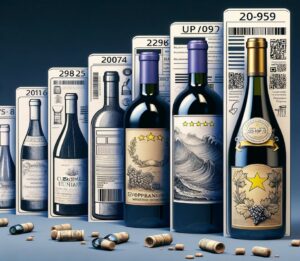
Labeling of food products, and wines in particular, has always been a major concern for European regulatory authorities. With the aim of increasing transparency and better informing consumers, the European Union (EU) has adopted new rules that will significantly modify wine labeling. Regulation (EU) 2021/2117, applicable from December 8, 2023, will oblige wine producers to provide additional information on their labels, marking an important step in the evolution of food labeling standards.
Sommaire
Legal context
These new obligations fall within the framework of Regulation 1308/2013 of December 17, 2013, also known as the “CMO Regulation” (Common Market Organization), which already defines several requirements for wine product labeling. These requirements include the denomination of the product category, specific mentions concerning the degree of alcohol, the Protected Designation of Origin (PDO) or Protected Geographical Indication (PGI) where applicable, as well as information on the bottler and importer.
Regulation (EU) No. 1169/2011, known as the “INCO Regulation”, which lays down the general principles of food information for consumers, will also apply to these new labeling rules, unless otherwise stipulated. The INCO Regulation has introduced a broad definition of what constitutes an “ingredient”, including any substance used in the manufacture of a foodstuff and present in the finished product.
New Labeling Obligations
The major changes introduced by Regulation (EU) 2021/2117 concern the obligation for wine producers to include a list of ingredients and a nutritional declaration on the label. This list may be limited to an indication of the product’s energy value, but a complete version of the list of ingredients must be available electronically. Allergenic or intolerance-causing substances must, however, be clearly indicated on the product’s physical label.This information can be presented directly on the bottle label, legibly and indelibly, or dematerialized, for example via a QR code. This flexibility of presentation reflects the EU’s desire to adapt to technological developments, while ensuring that consumers are fully informed.
Implications for Producers and Consumers
The new labelling rules are designed to enhance transparency and enable consumers to make informed choices. They underline the importance for wine producers of complying with these requirements to ensure the smooth circulation of their products within the EU internal market.
For producers, this means updating their labeling practices and potentially incurring additional costs to comply with the new rules. However, the transitional period provided for in the regulation, authorizing the disposal of stocks produced or imported before December 8, 2023, offers time to adapt their processes.
Legal implications
These changes raise several important legal issues:
Compliance and Sanctions: Producers must ensure their compliance with the new rules to avoid sanctions. Effective implementation of these requirements requires a review of labeling practices and technological adaptation for those opting for dematerialized solutions.
- Transparency and Consumer Protection: The main aim of these rules is to increase transparency and better inform consumers about the products they consume. This could have positive repercussions in terms of informed choice and public health.
- Impact on the international market: For non-EU producers, these requirements represent an additional challenge to access the European market. They need to align with these standards to maintain and expand their presence in this market.
- Practical and technical issues: The implementation of the dematerialized option raises practical issues, notably concerning the accessibility and reliability of online nutritional information and ingredient lists.
Conclusion
The adoption of Regulation (EU) 2021/2117 is a giant step towards a more transparent and regulated wine industry responding to growing consumer concerns about their health and the origin of the products they consume. However, their successful implementation will depend on the ability of producers to adapt to these requirements, and the willingness of the authorities to ensure effective and uniform application of the law.
Dreyfus et Associés, in partnership with a network of lawyers specialized in Intellectual Property, is positioned as a pillar for wine producers. We offer tailor-made assistance to navigate this new era of labeling, ensuring compliance while preserving the essence of each brand.

